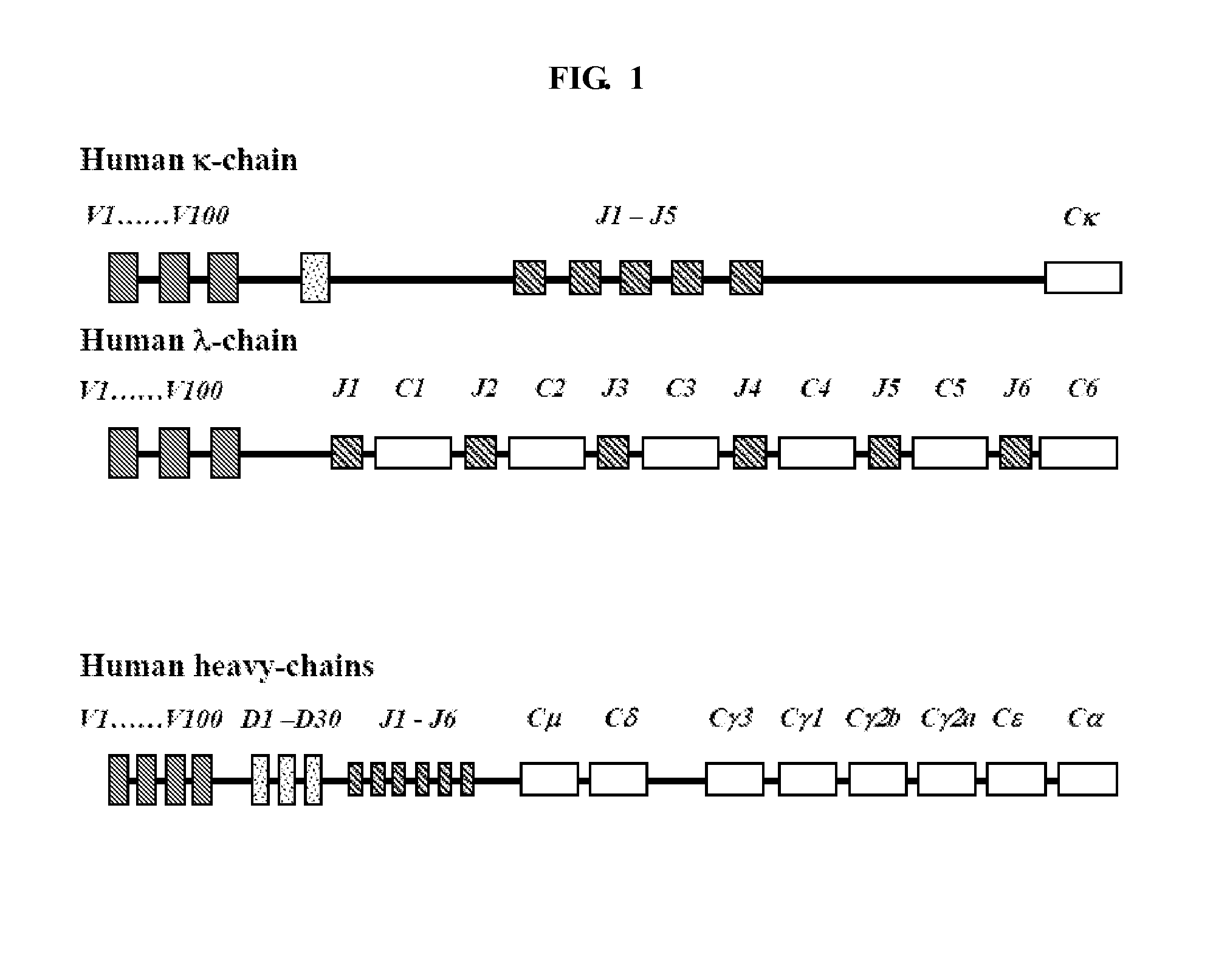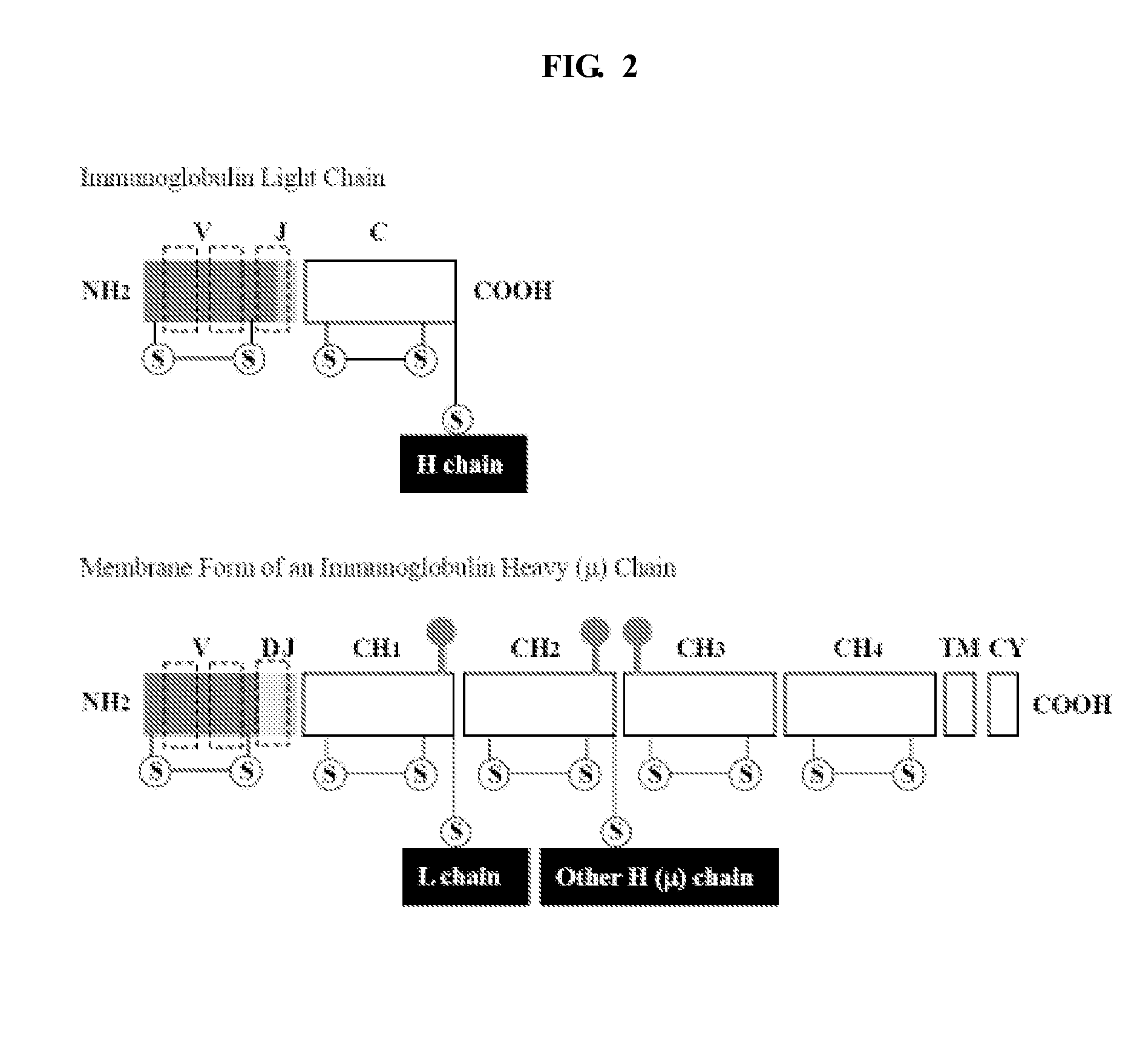Construction and use of a functionally human antibody library with maximized repertoire diversity
a functionally human antibody and repertoire technology, applied in the field of antibody libraries, can solve the problems of not being able to examine the level of humanness achievable from an immunological perspective, unable to achieve the level of humanness, and loss of antibody affinity and specificity, so as to and increase the diversity of the library
- Summary
- Abstract
- Description
- Claims
- Application Information
AI Technical Summary
Benefits of technology
Problems solved by technology
Method used
Image
Examples
example 1
Generation of a cDNA Database for Human Antibodies
[0095]Plasma cells and matured B cells are isolated from either the tonsil or peripheral blood of human donors. Tumor infiltrating B cells / plasma cells can be obtained directly from resected tumors. Solid tissue is first manually disaggregated in DMEM (Gibco, Rockville, Md.). This and all later steps are performed in conditions with maintenance of low temperature, and minimal, gentle handling to minimize cell lysis, a significant source of mRNA contamination of single cells. Both disaggregated tissues and blood samples are purified by centrifugation on a cool Ficoll gradient (Histopaque 1083, Sigma, St Louis, Mo.) for 20 min. at 2500 r.p.m. and 4° C. in a Sorvall benchtop centrifuge in order to enrich for plasma cells and lymphocytes. Samples can be stored at −80° C. in 10% DMSO until use. Cells are washed once in cold PBS, and pelleted at 2000 r.p.m. for 2 min. Plasma cells are stained with FITC-conjugated mouse anti-human CD38 (Cal...
example 2
Construction of a Human V-Region Library Containing Freely Assorted Framework Regions and CDRs
[0104]A sub-library of different heavy and light chain FR1, CDR1, FR2, CDR2, FR3, CDR3 and FR4 coding sequences may be generated from the Kabat database (Kabat et al., “Sequences of Proteins of Immunological Interest,” (5th Edition), US Dept Health and Human Services, US Government Printing Offices (1991)) as illustrated in Example 1.
[0105]All FR and CDR segments may be assembled from chemically synthesized oligonucleotides. Briefly, complementary DNA oligonucleotides of a particular sequence segment are chemically synthesized. Equimolar concentrations of the complementary oligonucleotides are mixed under annealing conditions to form blunt-end double stranded DNA segments. Sequence segments for different framework regions and CDRs derived from the database are kept either frozen or lyophilized for future use. When the sub-library size reaches the target diversity number, a library of V-regi...
example 3
Construction of a Phage Display Library
[0112]Variable immunoglobin (Ig) sequences VH and VL that are assembled from different FR and CDR segments (see Example 2) are joined together to form a DNA sequence encoding a single chain variable fragment (scFv) of an antibody by overlap PCR, using primers specific for the universal overhangs incorporated upstream and downstream of the assembled VH and VL sequences. The VH and VL sequences are joined via a peptide linker with the sequence of (GGGGS)3 (SEQ ID NO:15) (other linker sequences and lengths are possible). See FIG. 8.
[0113]PCR is carried out in 50 μl of reaction volume containing 1×PCR buffer (Invitrogen); 1.5 mM MgCl2 (Invitrogen); 0.2 mM dNTP (Promega); 0.04 U / μl of Platinum Taq polymerase (Invitrogen); 50 ng of synthetic Ig genes VH or Vκ, respectively, and 0.2 μM primers. After a 3-min. pre-denaturing step at 94° C., 25 extension cycles are carried out in a Mastercycler® personal PCR thermocycler with a 25-well aluminum plate (E...
PUM
| Property | Measurement | Unit |
|---|---|---|
| volume | aaaaa | aaaaa |
| volume | aaaaa | aaaaa |
| volume | aaaaa | aaaaa |
Abstract
Description
Claims
Application Information
 Login to View More
Login to View More - R&D
- Intellectual Property
- Life Sciences
- Materials
- Tech Scout
- Unparalleled Data Quality
- Higher Quality Content
- 60% Fewer Hallucinations
Browse by: Latest US Patents, China's latest patents, Technical Efficacy Thesaurus, Application Domain, Technology Topic, Popular Technical Reports.
© 2025 PatSnap. All rights reserved.Legal|Privacy policy|Modern Slavery Act Transparency Statement|Sitemap|About US| Contact US: help@patsnap.com



